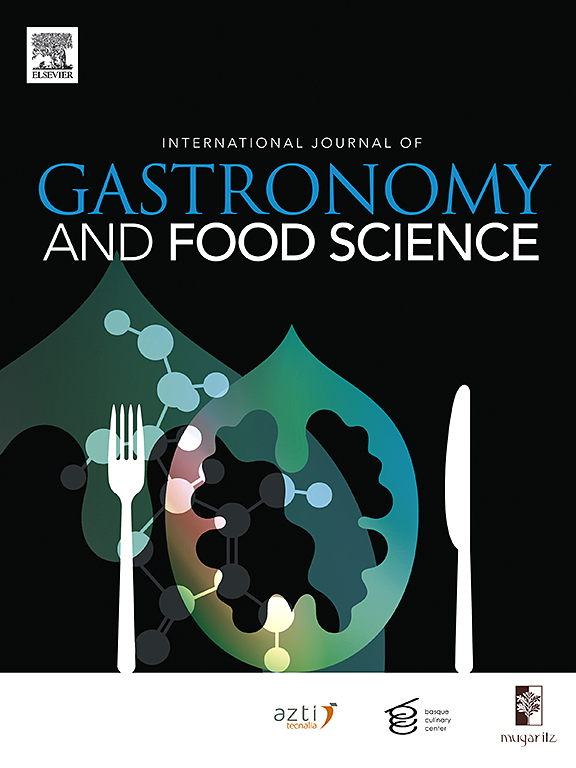Local amphibious cuisine: Toward the rediscovery of the gastronomic traditions of the palafito town of buenavista, Cienaga Grande Santa Marta, Colombia
IF 3.6
2区 农林科学
Q2 FOOD SCIENCE & TECHNOLOGY
International Journal of Gastronomy and Food Science
Pub Date : 2025-06-14
DOI:10.1016/j.ijgfs.2025.101218
引用次数: 0
Abstract
The aim of this study was to identify the main food sources and traditional gastronomic preparations of the palafito town of Buenavista in Colombia. During the fieldwork, the process of preparing traditional dishes was documented, and the sources of food, cooking techniques and traditional gastronomic preparations were identified to characterize the amphibious cuisine of the palafito town of Buenavista, Cienaga Grande Santa Marta, Colombia. The main findings of this study are as follows. The people in this region eat mainly fish products, cereals, tubers, some fruits and vegetables. Food is prepared in traditional three-stone stoves, and traditional cooking techniques include deep frying, stewing, stir frying, grilling, boiling, and reducing in sugar. Through culinary dialog, new gastronomic preparations were proposed without suppressing the cultural and traditional elements offered as snacks, main meals, desserts and drinks. In conclusion, from food sources to traditional gastronomic preparations and the passing on of culinary knowledge, the amphibious cuisine of the palafito town of Buenavista is characterized by food obtained from fishing and agricultural products purchased from nearby towns. This cuisine, which operates through a system of gastronomic routes, should be disseminated through food tourism and preserved through audiovisual records to value and rediscover this ancestral gastronomic tradition.
当地的两栖美食:走向重新发现布埃纳维斯塔,大圣玛尔塔,哥伦比亚的帕拉菲托镇的美食传统
本研究的目的是确定在哥伦比亚的布埃纳维斯塔的帕拉菲托镇的主要食物来源和传统的美食准备。在实地调查期间,记录了传统菜肴的制作过程,并确定了食物来源、烹饪技术和传统美食准备,以确定哥伦比亚大圣玛尔塔Cienaga Grande Santa Marta的palafito镇布埃纳维斯塔的两栖美食特征。本研究的主要发现如下:这个地区的人主要吃鱼制品、谷物、块茎、一些水果和蔬菜。食物是在传统的三石炉中准备的,传统的烹饪技术包括油炸、炖、炒、烤、煮和减糖。通过烹饪对话,在不压制小吃、正餐、甜点和饮料等文化和传统元素的情况下,提出了新的美食准备。总之,从食物来源到传统的烹饪准备和烹饪知识的传承,布埃纳维斯塔帕拉菲托镇的两栖烹饪的特点是从捕鱼和从附近城镇购买的农产品中获取食物。这种通过美食路线系统运作的美食应该通过美食旅游传播,并通过视听记录保存下来,以重视和重新发现这一古老的美食传统。
本文章由计算机程序翻译,如有差异,请以英文原文为准。
求助全文
约1分钟内获得全文
求助全文
来源期刊

International Journal of Gastronomy and Food Science
Social Sciences-Cultural Studies
CiteScore
5.30
自引率
10.50%
发文量
170
审稿时长
45 days
期刊介绍:
International Journal of Gastronomy and Food Science is a peer-reviewed journal that explicitly focuses on the interface of food science and gastronomy. Articles focusing only on food science will not be considered. This journal equally encourages both scientists and chefs to publish original scientific papers, review articles and original culinary works. We seek articles with clear evidence of this interaction. From a scientific perspective, this publication aims to become the home for research from the whole community of food science and gastronomy.
IJGFS explores all aspects related to the growing field of the interaction of gastronomy and food science, in areas such as food chemistry, food technology and culinary techniques, food microbiology, genetics, sensory science, neuroscience, psychology, culinary concepts, culinary trends, and gastronomic experience (all the elements that contribute to the appreciation and enjoyment of the meal. Also relevant is research on science-based educational programs in gastronomy, anthropology, gastronomic history and food sociology. All these areas of knowledge are crucial to gastronomy, as they contribute to a better understanding of this broad term and its practical implications for science and society.
 求助内容:
求助内容: 应助结果提醒方式:
应助结果提醒方式:


